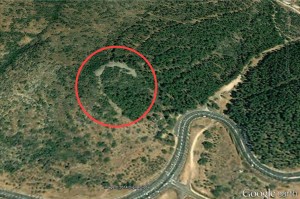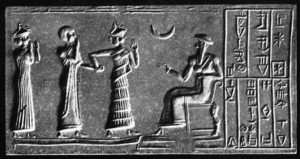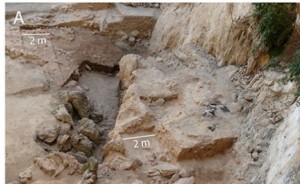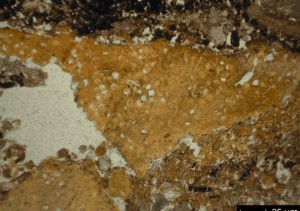Has there ever been anything in your life which turned out to be nothing of what you originally thought of? If so, then this phenomenon also turned out to be the case when archaeologists recently discovered the true purpose of a crescent-shaped stone monument in northern Israel.

Lunar monument located near the Sea of Galilee. Until recently, it was thought to be a portion of the walls of an old city.
The monument, which is located approximately 8 miles northwest of the Sea of Galilee, is measured at 150 meters (or 492 feet) in length with a height of 7 meters (about 23 feet) and a volume of 14,000 cubic meters (nearly 500,000 cubic feet). It is known to the locals of the area in Arabic as “Rujum en-Nabi Shua’ayb,” but it is also known by the name “Jethro’s Cairn”, a probable link to the Druze prophet Jethro who is mentioned in the Old Testament of the Bible. Along with the stone formation’s impressive size, it has also been dated based on pottery found in the structure as being built between the years 3050 and 2650 BC, making it older than the Great Pyramids of Egypt and Stonehenge in the United Kingdom.

Depiction of the Mesopotamian moon god Sin. The monument is thought to be devoted to the moon god by the inhabitants of nearby Bet Yerah.
Past work by archaeologists led many to the conclusion that the monument was once the part of a city wall, but recent work done by Hebrew University doctoral student Ido Wachtel has yielded no evidence of a nearby city. Rather than being city fortifications, Wachtel posits that the structure served as a symbolization for the ancient Mesopotamian moon god Sin, with the lunar crescent shape of the monument being one of Sin’s symbols. He supports this claim by also stating that a nearby ancient town named Bet Yerah (Hebrew for “house of the moon god”) is only a day’s journey from the structure, a distance which allows the monument to possibly serve as the town’s borders. As Wachtel wrote in a presentation to the International Congress on the Archaeology of the Ancient Near East, “The proposed interpretation for the site is that it constituted a prominent landmark in its natural landscape, serving to mark possession and to assert authority and rights over natural resources by a local rural or pastoral population.”
In terms of how the monument was built, Wachtel estimates that the job would have taken approximately 200 workers many months to complete, also keeping in mind the fact that those workers had to tend to their crops as well. The town of Bet Yerah, known in Arabic as “Khirbet Kerak,” was believed to have been thriving during the monument’s construction, with the inhabitants had good trade relations with early Egyptian rulers.
Nevertheless, an aerial view of the landscape displays a breathtaking site, one which now can be seen as a sacred location to those who once lived there. In addition to being a symbolic dedication to an ancient deity, the monument also serves as a potent symbol displaying Bet Yerah’s economic power at the time of its construction. Overall, the monument, although still leaving some unanswered questions, has served as a long-lasting reminder of Bet Yerah’s spiritual and cultural strength.
More Reading On This Topic Can Be Found At:
http://www.inquisitr.com/1478762/archaeologists-find-massive-5000-year-old-lunar-monument-in-israel/
Works Cited
Sabloff, Jeremy A. “Chapter Five: Why Cities?” Archaeology Matters: Action Archaeology in the Modern World. Walnut Creek, CA: Left Coast, 2008. 71-72. Print.
Jarus, By Owen. “Massive 5,000-Year-Old Stone Monument Revealed in Israel.” LiveScience. TechMedia Network, 15 Sept. 2014. Web. 15 Nov. 2014. <http://www.livescience.com/47835-massive-5-000-year-old-stone-monument-revealed-in-israel.html>.
Haaretz. “5,000-year-old Moon-shaped Stone Structure Identified in Northern Israel – Archaeology.” Haaretz.com. N.p., 16 Sept. 2014. Web. 15 Nov. 2014. <http://www.haaretz.com/archaeology/1.616140>.
Image 1: http://www.jspacenews.com/5000-year-old-moon-shaped-monument-found-israel/
Image 2: http://www.inquisitr.com/1478762/archaeologists-find-massive-5000-year-old-lunar-monument-in-israel/


